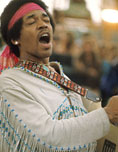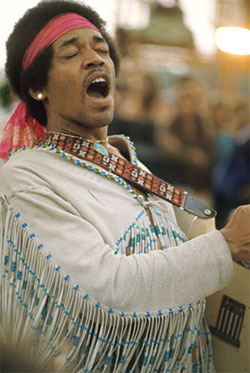Sept. 18: The Day Jimi Died


What could possibly add to the enormity of Jimi Hendrix’s music legacy in 2009 — 39 years after the still-ruling sonic genius of electric guitar departed the planet?
How about an entirely new and unprecedented Jimi Hendrix guitar model designed by the Hendrix family and Gibson? This astonishing about-to-be-unveiled guitar brand is destined to inspire a new generation of players as well as the legion of musicians already under the influence of Jimi’s magical sound and style.
Jimi’s sister Janie Hendrix talks about the new Jimi Hendrix model, the longstanding relationship between Gibson and the Hendrix family, and Jimi’s legacy — past, present, and future:
Why did you choose to work with Gibson to create the new Jimi Hendrix Signature Model?
JANIE: Creating this new guitar is continuing Jimi’s practice of giving back to people. He’d go to Manny’s Music store in New York to make himself available to young musicians or invite them to his studio to watch him record. He also gave away guitars or bought them for young players.
Part of the proceeds from the Jimi Hendrix guitar will be donated to the Jimi Hendrix Foundation, which is devoted to improving the quality of life for children, promoting artistic creativity, and world peace.
JANIE: It was our idea to approach Gibson in the beginning, after the positive experiences we’d had with the Flying Vs that Gibson made based on Jimi’s guitars. Our excitement inspired their excitement, and here we are, creating these new musical instruments. This is just the tip of iceberg. We want to have a whole line of Jimi-inspired instruments.
Get The Pick Newsletter
All the latest guitar news, interviews, lessons, reviews, deals and more, direct to your inbox!
What’s the history of collaboration between the Hendrix family and Gibson?
JANIE: When our family was fighting from ’92 to ’95 to get the rights to Jimi’s legacy back, Gibson created a beautiful Flying V like the one Jimi played at the Isle of Wight Festival, with his signature on it. The guitar came out in time to celebrate the 25th year of Jimi’s memorial, and we marked that anniversary with a concert that was part of Seattle’s Bumbershoot Festival, which was also celebrating its 25th year.
A few years later Gibson asked us to endorse another guitar: Gibson wanted to recreate the Flying V that Jimi painted himself, and we wanted them to. Gibson has also been sponsoring the annual Experience Hendrix Tours, which are part of our present, past, and future. They bring together artists who loved Jimi and want to recreate his music within their own creative scope. Having musicians like Los Lobos, Buddy Guy, Living Colour, and Kenny Wayne Shepard bring Jimi’s music to audiences today gives young people who weren’t able to hear Jimi live a chance to experience what Jimi called the “Electric Church” — a spiritual thing you could feel when he was on stage. These tours allow grandparents, parents, and children to experience Jimi’s music live and together. They’re something whole families can share, and Gibson makes that possible.
So we have a wonderful relationship with Gibson. They really get what we want when it comes to the tours and, now, the Hendrix model guitar. What’s really key is they want to work with us — to really collaborate.
How does the new Jimi Hendrix guitar model represent Jimi’s legacy?
JANIE: His inspiration, talent, and genius at guitar playing all fueled this instrument’s creation. For one example, Jimi turned right-handed guitars upside down and restrung them. That changed the way the strings and pick-ups interacted, which created a whole different sound. Now we’ve incorporated a new design into the placement of the pick-ups to help recreate that unique sound.
What other elements of Jimi’s playing and stagecraft are being designed into the Jimi Hendrix guitar?
JANIE: Well, that’s still being worked on, but we’re also trying to capture his sense of passion. The look of the guitar will reflect his stage presence and the clothing he wore. It’ll be very colorful.
You’re 18 years younger than Jimi. Did you see him live?
JANIE: I saw him perform five times. It was a family homecoming whenever Jimi returned to Seattle. Everybody put their lives on hold and the highlight was his concert. Being able to see him perform — sometimes we were sitting on stage and sometimes in the front row — was, well, loud [laughs] and awesome! When you listen to him on vinyl or CD you don’t get to see the magic of his fingers and arms moving, or his rings hitting the strings, or Jimi tuning as he played. To be within arm’s distance of him and to feel the electricity and energy coming from him as he played live is hard to describe.
How do you feel about Jimi’s legacy and it’s bearing on your family?
JANIE: This isn’t just a job. It’s an important part of who we are and a labor of love.
From ’92 to ’95 my father [James “Al” Hendrix, who died in 2002] and I fought to regain the rights to Jimi’s work, which sadly got away from us through a “trusted” attorney who had been representing us. Once we got the rights back we were able to establish Experience Hendrix, which acknowledges the fact that Jimi’s legacy goes beyond the idea of just selling records and being part of an industry. Not a day goes by when we don’t think about Jimi and honor his legacy and mission.
Our goal is to make sure Jimi’s legacy stays intact and that his music is put out in an authentic way — not the way the old administration did it. We want fans to be able to hear his music in the best possible way. With technology as good as it is, we can bring Jimi’s music — we have hundreds of original masters — to people in a pure form using those masters.
How much more of Jimi’s creative wealth can we expect to see and hear?
JANIE: We probably have another decade of music, including video. Every 12 to 18 months we’ll continue to have new releases and Dagger [Experience Hendrix’s label for board and audience recordings] official bootlegs. Jimi was a workaholic. After Electric Lady studios was built he was able to record constantly for as many hours as he wanted to. It’s almost as if he knew he had only four years to accomplish everything that he did. We have an amazing amount of original masters, including a lot of material that hasn’t been previously released.
Where are all of these tapes and films stored?
JANIE: We keep them in a temperature-controlled vault. We have a set of everything in Los Angeles and a set in New York, in the event of something catastrophic happening. We have duplicates of everything.
What’s coming up?
JANIE: We still have Monterey Pop and the Royal Albert Hall. For the Royal Albert Hall film, several cameramen followed Jimi, Noel [Redding], and Mitch [Mitchell] around Europe for about a month. We have a couple concerts and interviews that add up to about an hour-and-a-half program.
New things surface kind of magically, or at least serendipitously, when we’re working on a project. When we were preparing the Woodstock DVD we found out somebody had been standing on stage and filmed the whole show in black and white. People seemed to be in the right place at the right time when it came to Jimi, and these people have been happy to provide their recordings or other items because they want to make sure these things get into the right hands, which are the family’s. We’ve been very fortunate that Jimi as an artist was filmed and recorded by so many people and that they’ve made their tapes available.
What do you think Jimi would say about his position today as one of rock’s enduring icons?
JANIE: Jimi always said not to box him into any genre because it would only frustrate you and him. He looked at himself as a very unique artist who crossed all the genres of music and reached across all races and to both men and women. He wanted simply to be known as a musician and artist, and his music proves he succeeded in crossing all boundaries.
Since 1980, Guitar World has brought guitarists the best in-depth interviews with great players, along with exclusive lessons, informative gear reviews and insightful columns that help guitarists grow and excel on their instrument. Whether you want to learn the techniques employed by your guitar heroes, read about their latest projects or simply need to know which guitar is the right one to buy, Guitar World is your guide.
“Even the thought that Clapton might have seen a few seconds of my video feels surreal. But I’m truly honored”: Eric Clapton names Japanese neo-soul guitarist as one to watch
“You better be ready to prove it’s something you can do”: Giacomo Turra got exposed – but real guitar virtuosos are being wrongly accused of fakery, too










